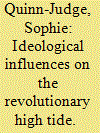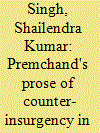|
|
|
Sort Order |
|
|
|
Items / Page
|
|
|
|
|
|
|
| Srl | Item |
| 1 |
ID:
110216


|
|
|
|
|
| Publication |
2011.
|
| Summary/Abstract |
Over the years, Hanoi historians have presented different views of the role of communist organizers in the events of 1930-31. Thanks to the opening of the Comintern archives, we can now see that in 1929-30 there was a strong shift in international communism towards revolutionary violence in all parts of the world. This paper discusses the ideological precedents and influences reaching Vietnam from Russia and the Comintern, as well as from the Chinese revolutionary movement. These include the slogans and political analysis of colonial countries that the Comintern and its agents were popularizing in Moscow, Paris and China. They also include the experience of peasant revolt in southern China, in particular what became known as the Hai-lufeng Soviets in Guangdong province in 1927-28, as well as Chinese left-wing politics of 1928-30, when Li Lisan was a dominant force. The author explores the idea that violent anarchism, with roots in the theories of early Russian revolutionaries, may have been a link between these disparate influences. An examination of the attitudes expressed by different Vietnamese communist leaders towards the revolutionary violence of 1930-31 forms an important part of this paper. To what extent were they in tune with the Comintern? Did they find other sources of inspiration closer to home? Were they simply riding a wave of peasant anger? In conclusion, the author discusses conceptions of what the Revolutionary High Tide represented in terms of political change in Vietnam. Was it the coming of age of the proletariat; an expression of peasant grievances that got out of control; or a first step on the path to independence?
|
|
|
|
|
|
|
|
|
|
|
|
|
|
|
|
| 2 |
ID:
144724


|
|
|
|
|
| Summary/Abstract |
Rebellions bringing together peasant-pastoralists, local dignitaries, and a few Sayyids prevented the Safavid monarchs from effectively controlling the political and economic activities in the province of Astarabad until the late sixteenth century. This paper investigates the nature of these rebellions led by the siyāh pūshān (wearers of black), and the socio-economic background and religious leanings of these rebels and their diverse allies. It also pays special attention to Astarabad's Sayyids, their intellectual formation, and their distinct approaches to the Safavid state from the early sixteenth century until the late 1570s when the uprisings lost much of their vigor. While heterodoxy may have been part of Astarabad's religious landscape, there is no evidence that it had a significant manifestation in the Siyah Push movement. More importantly, urban Shiʿi doctrinal and legal traditions had profound roots in Astarabad, nurtured by the Sayyids and promoted by the Betekchi dignitaries prior to the rise of the Safavids. This is significant given the fact that a group of Sayyids from Astarabad (especially the town of Fenderesk) were directly involved in the insurgency against the early Safavids.
|
|
|
|
|
|
|
|
|
|
|
|
|
|
|
|
| 3 |
ID:
144357


|
|
|
|
|
| Summary/Abstract |
This article suggests that the prose of counter-insurgency, as defined by Ranajit Guha, serves as a theoretical yardstick against which Premchand's discourses about peasants can be measured. This is possible, however, only if Guha's scope is broadened beyond historiography to incorporate fictional as well as journalistic writings. For someone who represents the plight of the peasant with incisive historical accuracy, Premchand's implied corrective for the peasant amounts to a radical departure from the status quo in the United Provinces. In Premchand's non-fictional prose, vis-à-vis the peasant uprisings of Awadh, there are only tangential references or a studied silence; however, his fictional works reveal the rationality of peasants, despite his insistence on compassion, rectitude and integrity. Nevertheless, he never presents peasant discontent as a collective enterprise; the alternatives are provided by the writer's leap of faith, either with the zamindar (landlord) or the sarkar (government). Premchand's literary corpus thus acts as a prose of counter-insurgency that reads peasants' protests as a threat to the social order and an impediment to the nationalist movement for swaraj (self-rule), thereby either relegating it to the peripheral spaces or discarding it altogether.
|
|
|
|
|
|
|
|
|
|
|
|
|
|
|
|
|
|
|
|
|